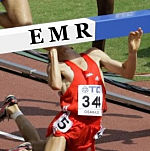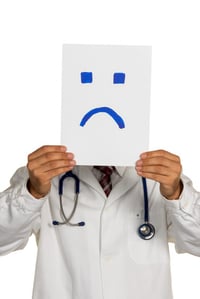 Stop Physician Burnout - 4th grade math shows the epic fail of the current practice of medicine
Stop Physician Burnout - 4th grade math shows the epic fail of the current practice of medicine
We don't need no stinking spreadsheets
==========
This is Blog Post #290
Complete Blog Library is Here
==========
Let me show you a simple, reproducible, fourth grade math demonstration of the power of team based care and up-staffing the back office. Along the way you will begin to sense the staggering waste in the current practice of medicine, caused in part by industry standards like the MGMA annual staffing survey.
============
We Build, Install & Support Corporate Burnout Prevention Strategy
Using Experience with 165 Clients to date -- CLICK to learn more
============
The reason EMR is killing doctors is simple -- OVERWHELM
Doctors were never meant to handle both
1) the complex interactions and thought processes of diagnose and treat, teach and manage patients
2) AND the digital documentation of those interactions via any one of the current truly demonic user interfaces.
 The implementation of EMR doubled the workload on the doctors.
The implementation of EMR doubled the workload on the doctors.
Most employers did not staff up to handle it. Instead, relying on annual staffing surveys to show them the average back office staffing ratio is the same as it was back in paper chart days - 1 Doc + 1 Medical Assistant.
That's right, the work load doubled without a change in the number of hands on deck. The documentation falls on the doctor simply because:
- we are ultimately liable for what is in the chart
- we don't punch the clock and stop working at 5PM
It is as if someone designed the system of care specifically to burn out doctors and now they use industry averages to reinforce the travesty. You can't design a more perfect meat grinder for the average doctor and now it is considered the standard of care.
The result:
- Two hours in the chart for each one hour of face time with patients - "Pajama time"
- Burnout rate in US physicians hovering at 50%
- It's a healthcare delivery failure of epic proportions
A 4th Grade review of the numbers reveals a way forward
What does doctor-only charting actually cost?
Let's look at costs here for a simple reason: that is the usual excuse for maintaining the 1:1 staffing ratio in the back office. And it is baloney ... as our fourth grade math below will show.
[Before we begin, please understand these numbers are assumptions and yours are certainly different. Plug yours into these calculations to find your specific answers. The calculations are as real and valid as gravity.]
Doctor Only Charting
Doctor's average hourly cost/pay = $150/hour
10 minutes of documentation/patient
20 patients/day
Daily Cost
(10 X 20)/60 X $150 = $500/day
What if someone else did the charting?
How about a "Super MA" = an MA who has been taught to scribe
Super MA average hourly cost/pay = $25/hour
Same 10 minutes per patient and 20 patients per day
Daily Cost
(10 X 20)/60 X $25 = $83/day and change
What are we saving here?
One day savings $417
Assume 16 practice days in a month.
Monthly savings = $6667
AND saving money is just the tip of the iceberg of benefits of adequate staffing ratios
1) BUT WAIT, THERE'S SO MUCH MORE:
This calculation only covers the EHR contribution of this extra pair of trained hands operating at the top of their license. This is just 3 hrs and 20 minutes of your Super MA's eight hour shift. Additional savings of the same $125/hour are available any time they can handle some of what the doctor is doing now to manage:
the InBox
Patient Portal
Lab Refills
Phone Calls
Prescription refills
and so much more
2) BURNOUT BE GONE:
This extra pair of hands just handed you those 3 hrs and 20 minutes of your life back to do different things in the office - and at home later that night - than hammering your brain into EPIC/Cerner/ECW/Meditech.
3) THIS DOES NOT LOSE MONEY:
The majority of physicians, given this level of support, will not struggle to see the 2 - 3 additional patients a day it takes to pay for the program.
4) THIS IS ALREADY WORKING IN THE REAL WORLD
This is why programs like APEX at the University of Colorado show such dramatic effects on burnout, turnover, quality and satisfaction - while remaining revenue neutral when they upstaff to 2.5 Super MA's per provider in their back office.
============
Compare this to current reality for most outpatient doctors
Most practice leaders in the US are ruled by industry standards that say one MA per doctor in the back office is "normal". So most outpatient docs get one MA and the organization calls it good. That person rooms patients and helps in various other ways with patient and documentation flow.  This 1:1 ratio leaves nearly the entire EMR and documentation flow stacked on the doctor's shoulders -- often to be completed at home, after hours.
This 1:1 ratio leaves nearly the entire EMR and documentation flow stacked on the doctor's shoulders -- often to be completed at home, after hours.
The result is a national physician burnout rate hovering at 50%.
Let me say that again. Current staffing averages are a clear and present cause of the burnout epidemic, NOT a standard to be adhered to.
The amount of wasted physician time and effort in the "normal" practice is truly staggering.
As I have said in previous blog posts, EMR should have been just a staffing issue. The time is NOW to staff up with adequate numbers of trained team members like Super MA's - and all forms of additional team members you see in Practice Transformation and Team Based Care projects around the country.
- EMR exploded the workload.
- Burnout is the price we paid.
The way forward is simple and obvious and under way in many locations.
It has taken nearly a decade to come full circle and it is clear that EMR should be just a simple staffing issue ... until the Gods of Artificial/Augmented Intelligence supposedly come to our rescue (please don't hold your breath).
If your organization does not have a team based care/practice transformation/upstaffing project up and running somewhere in the system, it is time to get started NOW.
CONTACT US if you want some help making that happen
============
PLEASE LEAVE A COMMENT:
What is your group doing to upstaff in the back office?
How is that working so far?
Savings calculation adapted from AMA Steps Forward module:
Creating the organizational foundation for joy in medicine.
Under: Reduce clerical burden due to the EHR

